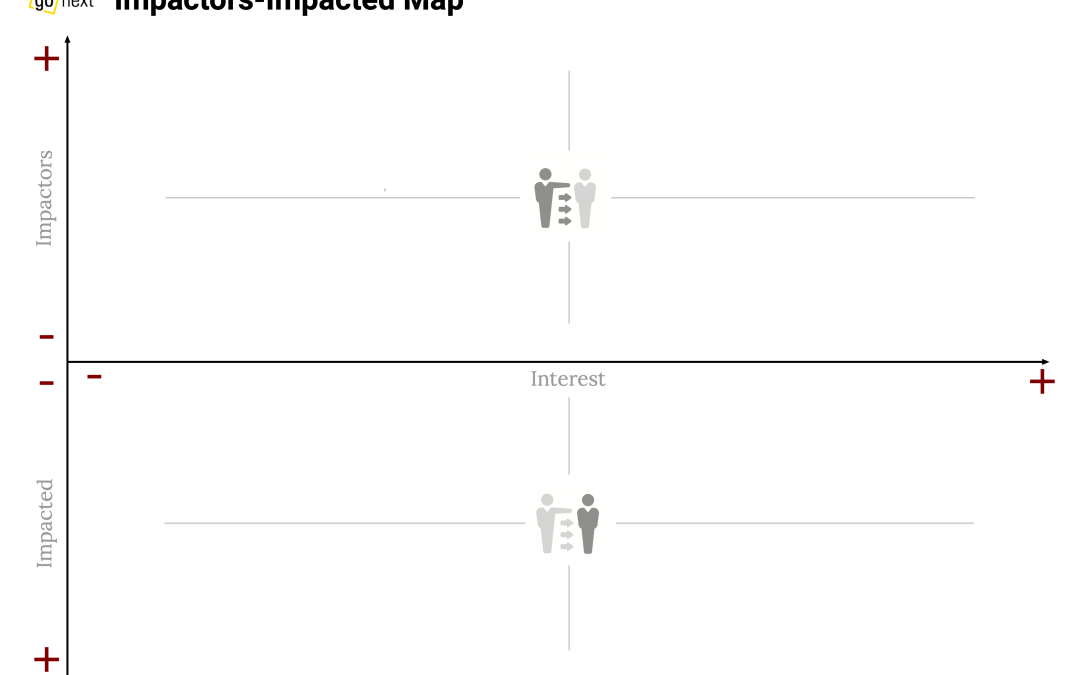The Impactors/Impacted map is a different take on a stakeholder map. It is a helpful tool that creates agreement and visualizes a team’s view on the relative importance of the stakeholders. It aims to separate the „impactors“ – the ones wielding the power – from the „impacted“ – the ones without power but possibly still highly interested in the outcomes of a project, fostering a more differentiated view on stakeholders.

Time
Typically around one hour.

People
Bring the whole project team.

Tools
Beyond printouts of themap you will need a selection of sticky notes and markers. Alternatively you can work online uploading the map to e.g. Miro.
When you are taking on a new assignment or starting a new project it is important to know who you are working for.
Any person, group or organization that has an interest in the project or is affected by its results is potentially a stakeholder.
Stakeholders can influence a project organization or its outcomes. Conversely, they can also be influenced by the actions, goals, and policies of a project organisation.
Depending on their position, stakeholders may have different degrees of power over a project or its outcomes.
A stakeholder map is a helpful tool that creates agreement and visualizes a team’s view on the relative importance of the stakeholders. It helps to answer the key question:
– How important is a stakeholder to the project?
The „Impactors/Impacted“ map is a stakeholder map where we separated the „impactors“ – the ones wielding the power – from the „impacted“ – the ones without power but possibly still highly interested in the outcomes of a project.
The map is fundamentally the „classic“ interest/power matrix mirrored at the x-axis. I.e. stakeholders highly interested and impacted do end up in the lower right corner of the diagram.
Other than in a classic stakeholder map, stakeholders may appear twice in this map: as „impactors“, wielding power over the project, as well as as „impacted“ by the outcomes of the project.
The map is used much like a „classic“ stakeholder map:
Download the canvas and print it out – or use it online with Miro or the like.
Have everybody in the team brainstorm for approximately five minutes who they perceive to be a stakeholder in the project and write their names on individual sticky notes.
Ask for a volunteer to come forward and put her sticky notes on the map while explaining her view on why she chose that particular position for the stakeholder in question.
Let the rest of the team add their stakeholders. If there is an overlap either consolidate identical stakeholders immediately or – in case of a different view on the position on the map – add them on a separate sticky note and have the team discuss and agree on the position later.
While adding and discussing stakeholders, zoom out from time to time to ensure that the relative positions of stakeholders make sense to the team.
Make sure that everyone agrees on the relevance of the stakeholders that are being added. Go for the stakeholders who may have a real impact on your project. Do not try to be completely exhaustive.
The following questions are helpful in determining whether a stakeholder should be represented on the map.
1. Does the stakeholder have a fundamental impact on your project’s performance or outcome? (Required response: yes.)
2. Can you clearly identify what you need or want from the stakeholder? (Required response: yes.)
3. Is the relationship dynamic — that is, do you want it to grow? (Required response: yes.)
4. Can the project succeed without the stakeholder – can she easily be ignored? (Required response: no.)
5. Are the needs or interests of the stakeholder already represented by another stakeholder? (Required response: no.)
Jointly review the resulting map. The distribution into different quadrants should determine your communication with the stakeholders in question.
If there are any stakeholders that you would want to move on the map, you may need to change your attitude and/or communication towards them. Develop an action plan. Which concrete measures can you think of to achieve the desired re-positioning?
Impactor/impacted maps are not static. Review and update your map regularly.
Dos and Don’ts
- Make it a work meeting – ensure everyone participates. Try and get the relative positioning right.
- Don’t try to map ALL stakeholders to a project!!!
This tool was designed at go3consulting PartG. The copyrights are owned by go3next GmbH. It may be used under the terms of the Creative Commons Attribution-NonCommercial-ShareAlike 4.0 international license – see creativecommons.org

